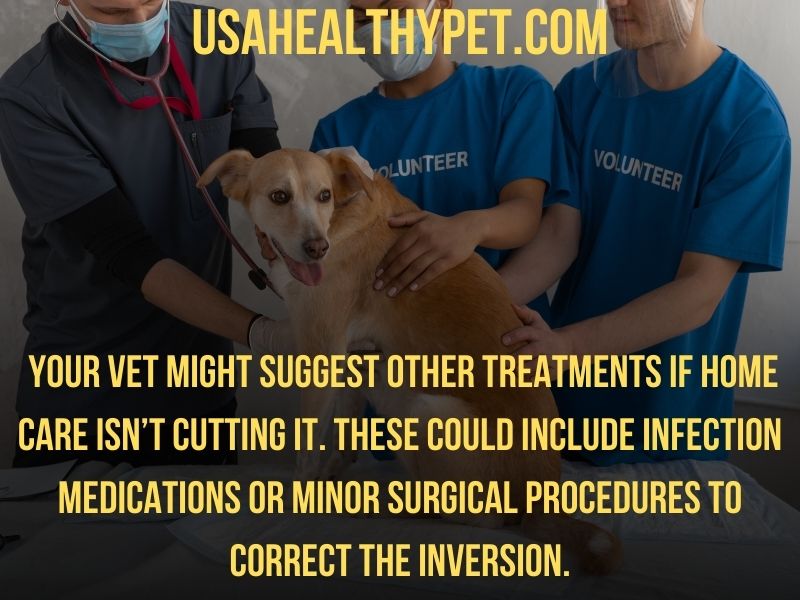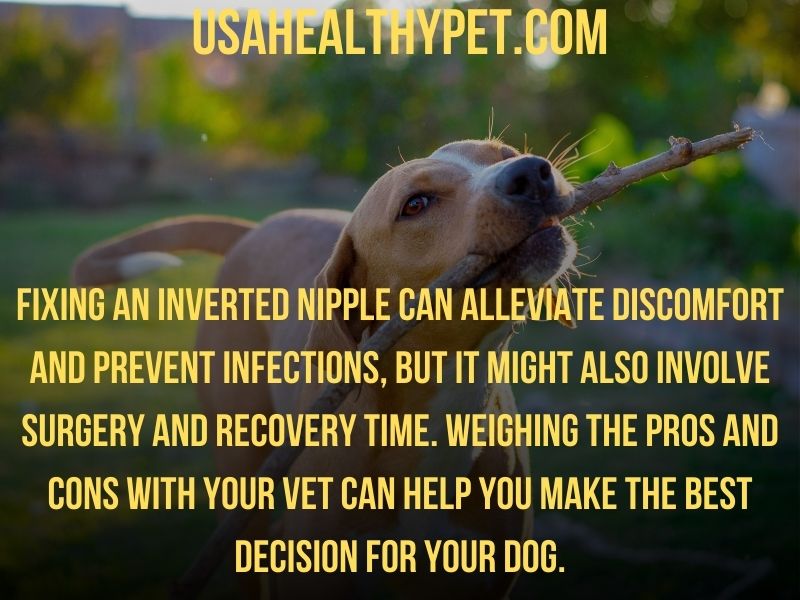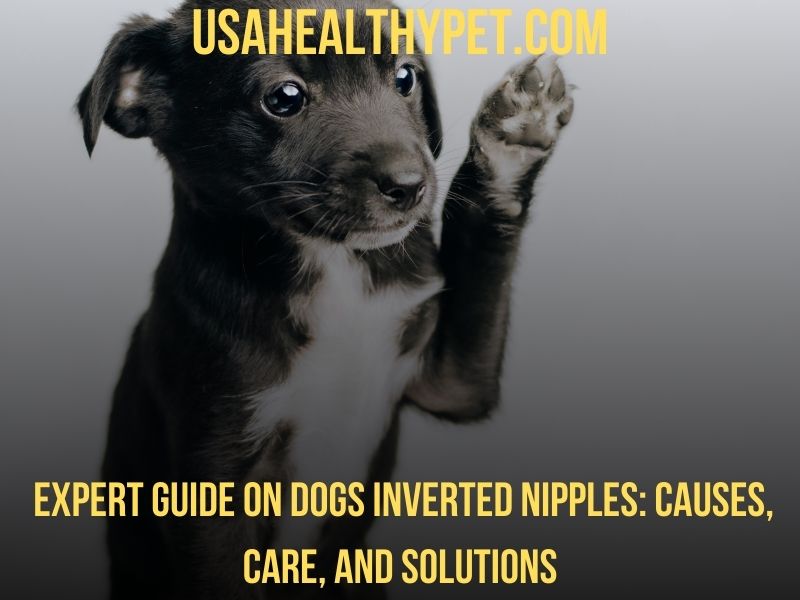Notice something a bit odd with your dog’s nipples? Don’t worry, you’re not alone! Both male and female dogs can have inverted nipples, and it’s especially common in those who are pregnant or nursing.
Most of the time, it’s just a unique feature and nothing to stress over. However, in some cases, it can indicate a health issue.
If you spot swelling or discharge, or your dog seems to have trouble nursing, these could be signs of an infection like mastitis, and it’s time to see the vet.
So, what does an inverted nipple look like? It’s pretty much when the nipple pulls inward instead of sticking out.
This guide will help you understand why dogs get inverted nipples, how to care for them, and when it’s time to get professional help. Remember, if you’re ever in doubt about your dog’s health, it’s always best to check in with your vet.
- Causes Of Inverted Nipples In Dogs
- Symptoms of Inverted Dog Nipples
- Are Inverted Nipples In Dogs Dangerous?
- Inverted Nipples In Nursing Dogs
- How To Treat Inverted Nipples In Dogs
- Should I Fix My Dog’s Inverted Nipple?
- Conclusion
- FAQs
- 1. Can inverted nipples in dogs heal on their own?
- 2. Is it common for puppies to have inverted nipples?
- 3. Can inverted nipples affect a dog’s ability to nurse her puppies?
- 4. What should I do if I notice a discharge from my dog’s inverted nipple?
- 5. Are there any breeds more prone to inverted nipples?
Causes Of Inverted Nipples In Dogs
So, why does this happen? There are several reasons why your dog’s nipple might be inverted. Let’s break it down:
Genetics
Just like humans, dogs can inherit physical traits from their parents. Some dogs are just born with inverted nipples. It’s in their DNA.
Developmental Factors
During the puppy stage, some dogs may develop inverted nipples as they grow. It’s a part of their body’s unique way of forming.
Trauma or Injury
In some cases, an injury or trauma to the nipple area can cause it to retract. Imagine a playful pup getting into all sorts of mischief – accidents can happen!
Pregnancy and Nursing
Pregnancy and nursing can also play a big role. When a female dog is pregnant or nursing, her nipples go through a lot of changes.
Sometimes, they might not return to their original state and end up inverted. It’s a bit like how human bodies change after having a baby—sometimes things don’t go back to exactly how they were before.
Health Conditions
Certain health conditions can lead to changes in the nipple’s structure. These might include infections, tumors, or other underlying issues.
It’s always best to keep an eye on any changes in your dog’s body and consult with your vet if you notice something unusual.
Symptoms of Inverted Dog Nipples
Wondering how to spot an inverted nipple? Here are some signs to look out for:
Visual Cues
The most obvious sign is the appearance of the nipple itself. Instead of sticking out, it will appear sunken or flat against the skin.
Skin Changes
You might notice redness, swelling, or even discharge around the area. These changes can indicate an infection or irritation.
Behavioral Signs
Is your dog licking or scratching at the nipple more than usual? This could be a sign that something’s bothering them.

Are Inverted Nipples In Dogs Dangerous?
Now, you might be thinking, “Is this something I should worry about?” The short answer is: it depends.
Normal Variation
For many dogs, an inverted nipple is just a quirky trait. It doesn’t cause any harm and doesn’t need any special treatment.
Potential Issues
However, if the inverted nipple is accompanied by other symptoms like swelling, redness, or discharge, it could indicate an infection or other health issue. In such cases, a visit to the vet is a good idea.
Expert Opinion
Dr. Jane Smith, a renowned veterinarian, says, “Inverted nipples in dogs are usually harmless, but any sudden changes or signs of discomfort should be evaluated to rule out infections or other complications.”
Note: The expert opinion was found with the help of ChatGPT.
Inverted Nipples In Nursing Dogs
This topic gets even more interesting when we talk about nursing dogs. Let’s dive in.
Challenges for Nursing Puppies
Inverted nipples can make it difficult for puppies to latch on and nurse properly. This can lead to frustration for both the mother and her pups.
Possible Solutions
Techniques and tools are available to help puppies nurse, even with inverted nipples. Some dog owners use nipple shields or gently massage the nipple to help it protrude temporarily.
Veterinary Assistance
If you’re struggling, don’t hesitate to seek help from your vet. They can provide guidance and support to ensure the puppies are getting the nutrition they need.

How To Treat Inverted Nipples In Dogs
Do you have an inverted nipple situation on your hands? Here are some steps you can take:
Home Care
For minor cases, home care can be quite effective. Gently massaging the area can sometimes help the nipple to pop out. Keeping the area clean and dry is also crucial to prevent infections.
Veterinary Treatments
Your vet might suggest other treatments if home care isn’t cutting it. These could include infection medications or even minor surgical procedures to correct the inversion.
Preventive Measures
Regular check-ups and monitoring your dog’s health can help catch any issues early on. Keeping your dog clean and well-groomed can also prevent problems from arising.
Should I Fix My Dog’s Inverted Nipple?
This is a common question, and the answer isn’t always straightforward.
When It’s Not Necessary
If the inverted nipple isn’t causing any problems, there’s usually no need to fix it. Many dogs live happily and healthily with inverted nipples.
When It’s Recommended
If the nipple is causing discomfort, infections, or problems with nursing, your vet might recommend treatment. Each case is unique, so it’s best to discuss it with a professional.
Pros and Cons
Fixing an inverted nipple can alleviate discomfort and prevent infections, but it might also involve surgery and recovery time. Weighing the pros and cons with your vet can help you make the best decision for your dog.
Conclusion
Finding an inverted nipple on your dog can be a bit surprising, but it’s often just a harmless quirk. Whether it’s due to genetics, trauma, or changes during pregnancy and nursing, most inverted nipples are not a cause for concern.
However, it’s crucial to monitor for any signs of infection, like swelling, discharge, or nursing difficulties, as these can indicate a need for veterinary attention.
By understanding the causes and knowing how to care for inverted nipples, you can help ensure your furry friend stays happy and healthy. Remember, when in doubt, always consult your vet.
They’re your best resource for keeping your dog in tip-top shape. Embrace your dog’s unique features and enjoy the journey of pet parenthood!
FAQs
1. Can inverted nipples in dogs heal on their own?
In some cases, yes. Minor inversions might correct themselves over time, especially with gentle massage and care. However, persistent or problematic cases should be evaluated by a vet.
2. Is it common for puppies to have inverted nipples?
Yes, it’s relatively common for puppies to have inverted nipples. This can be a developmental trait that they outgrow, or it might persist into adulthood.
3. Can inverted nipples affect a dog’s ability to nurse her puppies?
Yes, inverted nipples can make it challenging for puppies to latch on and nurse. However, with proper techniques and veterinary support, most nursing issues can be managed effectively.
4. What should I do if I notice a discharge from my dog’s inverted nipple?
Discharge can be a sign of infection or other underlying issues. It’s important to consult your vet promptly if you notice any unusual discharge from your dog’s nipples.
5. Are there any breeds more prone to inverted nipples?
While inverted nipples can occur in any breed, there doesn’t appear to be a specific breed predisposition. It’s more about individual genetics and development than breed characteristics.

Pingback: Understanding Pembroke Corgi Tails: Natural vs. Docked Tails
Pingback: Explaining Dirt-Like Brown Spots on Your Dog's Belly